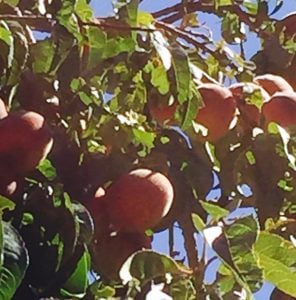Successfully raising seeds in a greenhouse for next year’s crop is just one of the many pleasures and contentments of gardening. But there are others.
The garden year is ending and it’s time we took stock of our gardens and the successes and failures experienced from which we can learn what works…and what doesn’t require further effort (unless, of course, you’re grimly determined.)
My reward this year has been an abundance of peaches yielded from a beat down, abused tree I thought was beyond redemption. Its limbs had been lashed with clothesline to “keep it tidy”, but the bark had overgrown the restraints and the wounds were painful to look at. But freed, gently pruned, watered and hugged (on occasion, yes, I hug trees), it’s produced enough freestone fruit for the neighbors, the dog, the squirrels and us.

Talk about grimly determined! I’m so excited, I can hardly stand it, thinking of next year’s peach flowers, glossy foliage and globes of sweetness to come to be preserved in jam, chutney, or brandied and spiced for Christmas treats.

The tomatoes, however, were a total failure. But my reward is in the thrill of having homegrown anything this year. Add this to my sense of achievement at having kept the old tree alive and happy for, I hope, at least several more years, and you’ve got the recipe for why it’s easy to find gardening incredibly rewarding.
Gardening is surely the best way to interact with nature, to really become part of life’s rich processes. Swimming with dolphins is okay, but talking to (and hugging) plants is much more enriching. Apart from communing with nature, you meet the nicest people when you become part of a gardening network sharing advice as well as cuttings and rooted offshoots; in time your garden becomes a living friendship quilt.
My gardens have always been crowded with friends; a rose from Jacque’s garden near Cannes, a white-flowered cenizo from Rosa, salvias collected by Betsy, three full-grown crape myrtles Roger salvaged from a building site. Every one of my gardens has had sweet-scented, pale blue Florentine iris tucked in a border, a house-warming gift from Alessandro when visiting from Tuscany (he’s also the source of the tomato seeds, so there’s more where they came from). Now I’m getting set to plant those iris I wrote about last month, taken from my son’s and daughter-in-law’s garden. Each bloom will be a reminder of them as they follow their Army careers to far places. For me every plant has a story, and the garden is my résumé. And as you walk around your patch, ignore the mistakes and instead, remember good times and recognize each friend as you pass by.

The second most precious gift gardening can give is by teaching us the value of patience – there’s no such thing as an instant garden. Thus, I watch and wait while seedlings grow into trees; follow the seasonal rituals of weeding and pruning to maximize the growth potential of the plants and my ground. Best of all, I look to the future, planning for new features, new plants and new friends. Some people pay big bucks to listen to self-help gurus. Me? I’ll be in the garden.
Text and photos©Ethne Clarke, 2016


